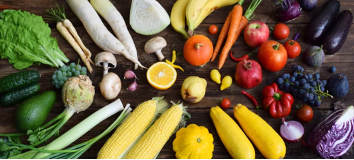Written by UConn Dietetics student Alison David
It’s well known that it’s an important health practice to eat as many fruits and vegetables as possible, everyday. Did you know

that the variety of colors matters? By ‘eating the rainbow’, you get the benefits of many vitamins and minerals that are unique to these foods. The variety of colorful fruits and vegetables can help you to take in very important compounds called phytonutrients, and especially antioxidants, the chemicals in fruits and vegetables that protect our bodies from cancer producing agents1.
According to the National Institutes of Health, antioxidants are vitamins and other nutrients that help protect your cells from damaging effects of free radicals1. Free radicals are in our bodies from digestion, and toxins found in the environment. These radicals and toxins may contribute to the development of serious health problems like cancer and heart disease. Antioxidants can fight these free radicals for us. The best sources of antioxidants are healthy whole foods and vividly colored vegetables and fruits.
For example, the antioxidant, lycopene, which is often found in red fruits like tomatoes, watermelon and pink grapefruit is shown to be anti-inflammatory which contributes to overall health. It may also benefit heart health, may reduce sun-related skin damage, lower your risk of certain cancers and have positive effects on your immune system.2
These are examples of antioxidants you may have heard of because many are actual vitamins: Vitamins A, C, E; Beta-carotene; Lutein; Selenium; Manganese and Zeaxanthin. Each antioxidant serves a different function and is not interchangeable with another3. This is why it is important to have a varied diet.
Examples of Phytonutrient Rich Foods1
- Peaches, mangos, melons, citrus fruits, and berries)
- Dark green leafy vegetables (such as spinach, kale, bok choy, broccoli, Swiss chard, and romaine lettuce)
- Whole grain products (such as brown rice, wild rice, whole wheat whole grain breads and whole grain cereals)
- Nuts and seeds (such as walnuts, almonds, sunflower, sesame and flax seeds)
- Legumes (such as dried beans, peas, lentils, soybeans and soy products)
Ways to Include Fruits and Vegetables:
Fruits and vegetables can easily be added to meals and snacks! Fruits like bananas, apples, clementines, and peaches travel well for snacks at work or on the go! A side salad at dinner with a variety of vegetables can help to increase your daily intake. Try combining fruits and vegetables with a source of protein or fat such as nuts or cheese to make a balanced and filling snack!
Citations
- The Difference Between Antioxidants and Phytochemicals. American Institute of Cancer Research. November 16, 2015. https://www.aicr.org/resources/blog/healthtalk-whats-the-difference-between-an-antioxidant-and-a-phytochemical/. Accessed February 23, 2022.
- National Institutes of Health – MedlinePlus; Antioxidants. Accessed February 23, 2022.
- Phytonutrients – Nature’s natural defense. Phytonutrients – Nature’s Natural Defense – Unlock Food. (n.d.).https://www.unlockfood.ca/en/Articles/Vitamins-and-Minerals/Phytonutrients-%E2%80%93-Nature%E2%80%99s-Natural-Defense.aspx. Accessed March 2, 2022.
- Davidson, K. (2020, December 18). How to eat the rainbow: Tips for a colorful diet. Healthline.https://www.healthline.com/nutrition/eat-the-rainbow#The-colors. Accessed March 2, 2022.
This material is funded by UDSA’s Supplemental Nutrition Assistance Program (SNAP).
This institution is an equal opportunity employer.